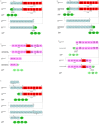Natural transformation facilitates transfer of transposons, integrons and gene cassettes between bacterial species
- PMID: 22876180
- PMCID: PMC3410848
- DOI: 10.1371/journal.ppat.1002837
Natural transformation facilitates transfer of transposons, integrons and gene cassettes between bacterial species
Abstract
We have investigated to what extent natural transformation acting on free DNA substrates can facilitate transfer of mobile elements including transposons, integrons and/or gene cassettes between bacterial species. Naturally transformable cells of Acinetobacter baylyi were exposed to DNA from integron-carrying strains of the genera Acinetobacter, Citrobacter, Enterobacter, Escherichia, Pseudomonas, and Salmonella to determine the nature and frequency of transfer. Exposure to the various DNA sources resulted in acquisition of antibiotic resistance traits as well as entire integrons and transposons, over a 24 h exposure period. DNA incorporation was not solely dependent on integrase functions or the genetic relatedness between species. DNA sequence analyses revealed that several mechanisms facilitated stable integration in the recipient genome depending on the nature of the donor DNA; homologous or heterologous recombination and various types of transposition (Tn21-like and IS26-like). Both donor strains and transformed isolates were extensively characterized by antimicrobial susceptibility testing, integron- and cassette-specific PCRs, DNA sequencing, pulsed field gel electrophoreses (PFGE), Southern blot hybridizations, and by re-transformation assays. Two transformant strains were also genome-sequenced. Our data demonstrate that natural transformation facilitates interspecies transfer of genetic elements, suggesting that the transient presence of DNA in the cytoplasm may be sufficient for genomic integration to occur. Our study provides a plausible explanation for why sequence-conserved transposons, IS elements and integrons can be found disseminated among bacterial species. Moreover, natural transformation of integron harboring populations of competent bacteria revealed that interspecies exchange of gene cassettes can be highly efficient, and independent on genetic relatedness between donor and recipient. In conclusion, natural transformation provides a much broader capacity for horizontal acquisitions of genetic elements and hence, resistance traits from divergent species than previously assumed.
Conflict of interest statement
The authors have declared that no competing interests exist.
Figures

References
-
- Boucher Y, Labbate M, Koenig JE, Stokes HW (2007) Integrons: mobilizable platforms that promote genetic diversity in bacteria. Trends Microbiol 15: 301–309. - PubMed
-
- Mazel D (2006) Integrons: agents of bacterial evolution. Nat Rev Microbiol 4: 608–620. - PubMed
-
- Hall RM, Collis CM (1995) Mobile gene cassettes and integrons: capture and spread of genes by site-specific recombination. Mol Microbiol 15: 593–600. - PubMed
Publication types
MeSH terms
Substances
LinkOut - more resources
Full Text Sources

